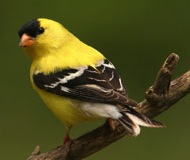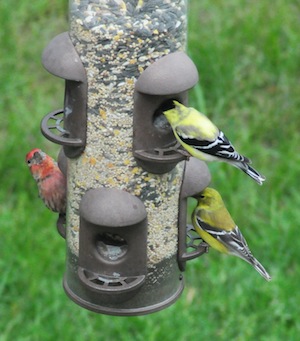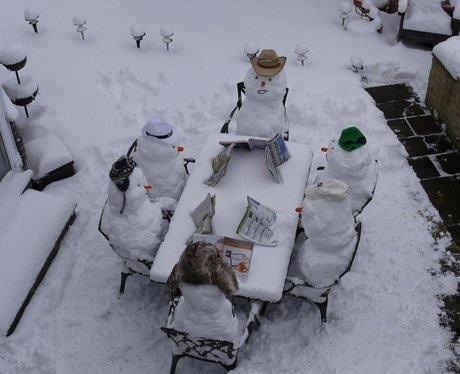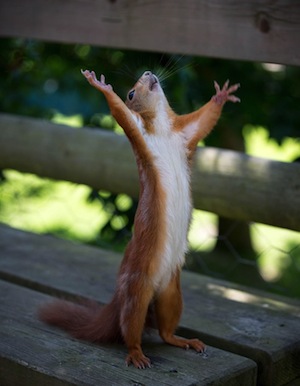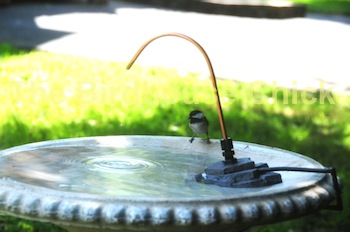-
The American Goldfinch and a Nyjer Feeder
Goldfinches happen to be one of the latest nesters, we have always conveyed this, but never with the logic behind why this is so. The following appeared on ListServe and answers the question to a T. Pretty interesting stuff!
I don’t know much about them, but I have heard that they wait to nest until dandelion thistle is available. Any truth to this?
“American Goldfinches are really interesting birds. I don’t think it’s understood scientifically, but they do time their nesting very closely to the flowering of the entire true thistle family, although they eat a wide variety of small seeds. (They aren’t dependent on dandelion seeds, since dandelions go to seed all season long.) They are almost completely dependent on a seed diet, even feeding their nestlings a seed slurry from their crops (unlike most songbirds–even the seed-eaters–which feed insects to their kids). In part, it is believed that they can feed seeds to growing nestlings because thistle seeds, easily plucked from a nyjer feeder, are so high in protein, compared to other seeds. We used to have a real struggle raising orphaned goldfinches in rehab until we understood the importance of the high protein content of the thistle seeds with which the babies grow up. We used to feed them a seed-based formula, since that’s what the adults do, and they typically failed to thrive. However, once we switched to the insectivorous formula (which doesn’t contain insects per se but has more protein than the seed-based formula does), many of the problems resolved.
Goldfinches are known to eat small seeds other than those from a nyjer feeder This interrelationship with the thistle family makes American Goldfinches pretty much the latest avian breeder in North America, since thistles bloom very late in the season (late July and early August here). At the wildlife rehab center, you know the breeding season is coming to a close when you start to hear those incessant, piercing baby contact call notes ringing through the center halls, boring a hole into your so-totally-done-with-baby-bird-season brain. Music to my ears personally.
Not much action in the nest boxes in central Colorado, although we have one completed White-breasted Nuthatch nest and one that just needs the inner lining. Juniper Titmice and Mountain Chickadees are singing; I hear the downward “phew, phew” calls of Mountain Bluebirds moving around the property. The Golden Eagle in the rock cliff nest over the Arkansas River has been incubating for ~4 weeks, so chicks should hatch in the next couple of weeks. The American Dippers nesting at the bridge across the Arkansas are feeding noisy chicks and the adults are nearly a constant blur in and out of the river scarfing up aquatic insects for them all. Last week in Coaldale, we had ~10″ of snow (only 1-4″ predicted)
that had completely melted/evaporated 24 hours later. (Major snow dump on Tues.; on Thurs., I was checking nest boxes in shorts and a t shirt.) Now, here in the metro Denver area, we’re facing the possibility of 3 days of snow (a rarity here in the arid west) with 6-9″ forecast for us in the western ‘burbs and highs in the 30s those days. Back to winter for a while…”
Posted by Tina Mitchell, Coaldale, CO
-
first sprite spotted today at the window hummingbird feeder
I think he’s celebrating, hallelujah… spring has sprung!
The very first hummingbird was spotted today, bringing sheer delight in knowing they’re back. For the next six to seven months, sights and sounds around the yard will be a-brimming with silly antics and buzzing activity from these favorite migratory birds. Their very own Pop’s Hummingbird Swing was installed last season and it proved to be a huge hit, so we’ll likely add another this year.
Although feeders are out, there aren’t any flowers yet from which to draw nectar, and that part’s kinda sad. Nothing’s been done in the yard as far as clean-up and planting colorful annuals for the season.
Perennials have not started blooming except for the very early – and long gone crocus and jonquils. Some white candy tuft clumps perch upright in a barren looking landscape, while trees are just sprouting tender green foliage. Leaf misters (that never made it to storage last year) sit ready to spray, and the popular Hummer Helper nesting material is also ready for action!
Because this one hangs from a sturdy window bracket, it serves as our window hummingbird feeder, and eyes are peeled when in the kitchen.
So nice having a feeder right at the window again… and one that squirrels won’t bother with!
- Bath Heaters & Deicers, Bird Accessories, Bird Baths, Birding Accessories, Heated Bird Bath, Misters and Birdbath Drippers, Uncategorized
heated bird baths, in April, in Georgia?
Usually by April spring has already sprung here in North Georgia, but 2013 is quite the contrary. This should be the scene, when heated bird baths are removed for storage and birdbath drippers take their place. Not so – not yet anyway 🙁
Yesterday morning when I went out to feed the birds (a daily ritual)… my hands were actually numb! Wet, windy and downright freezing cold, birds were puffed up like little balls, trapping air pockets between feathers to stay warm. It’s really tough on the insect-eating birds because there’s no insects yet! Migrations are under way, but landscapes are not very accommodating at this point. What was it- like 15 inches of snow in IL last week…. uuggh, it’s enough of winter already, hummingbird feeders went up last week for Pete’s sake! They just don’t go with heated bird baths.
Later that day a friend told me it was a record-breaking temperature, the highest
low temp for GA on record since the 1880’s. Well today was beautiful, with projections in the 70’s and 80’s for the next few weeks. Maybe it’s a sign that spring is finally here to stay? Let’s hope so! And if it’s not, this birdie may be heading further south real soon!

